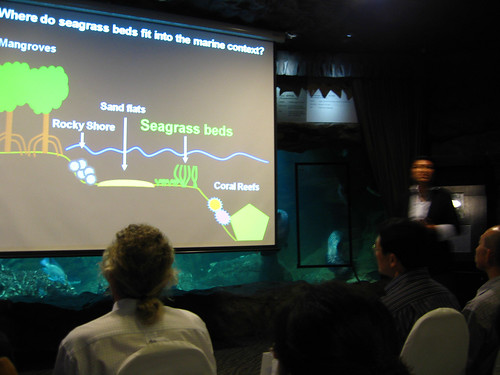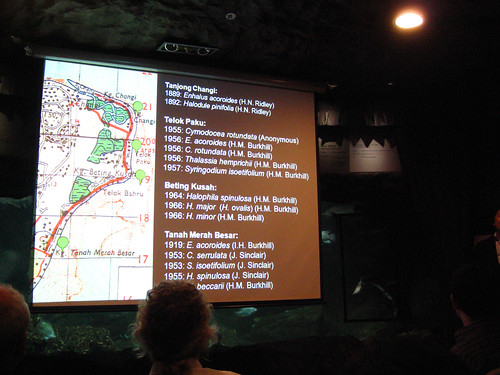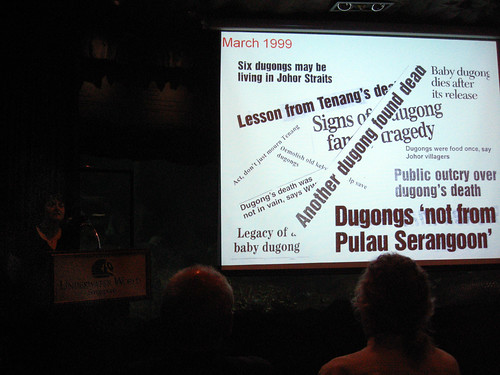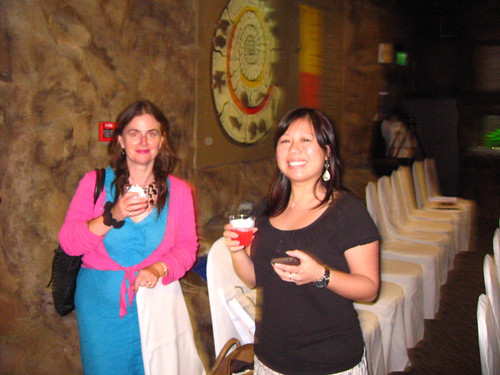Thought coral reefs were the "rainforests of the sea"?
 October 9, 2009
October 9, 2009

Well, if you were at Siti M Yaakub’s talk about sea grasses this evening, you would’ve heard something else! Turns out sea grass beds are worth about ten times more to the global economy than rain forests! Siti’s enthusiastic presentation made learning about seagrasses fun and fascinating! With the simple diagram above (which Siti claims she took a mere hour to draw!) she managed to introduce seagrass habitat, and the habitats it interacts with, in very palatable manner! I learned that there’s a new record of seagrass in Singapore, Halophila decipiens, that looks similar to Halophila ovalis but grows in deeper waters. After a quick chat with Siti after the talk, the Hantu Blog looks forward to diving with her at Pulau Hantu to see if we can find this fuzzy-leafed marine plant!

Siti also included interesting facts with the help of the above map of Singapore from the mid 1900s. The map showed that before major land reclamation, what is now East Coast Park used to be a sea grass sand flat! Imagine what it must’ve looked like to early biologists and explorers! It must’ve been crawling with sea turtles, sea stars and seahorses!

Now that we knew all that there was to know about seagrasses (or was possible to know!) in 15 minutes, we graduated to learning more about dugongs with a presentation by Prof. Helene Marsh from James Cook University, who’s spent more than a decade researching about dugongs and the environments and people with which they interact with. She began her presentation by reflecting on an incident that occured in Johor that involved a baby dugong getting trapped in a kelong or floating fishing pen. When Prof. Marsh visited Malaysia in 1999 she saw close to 20 dugongs in and around Johor during a single helicopter survey! Dugongs are able to travel up to 500km within a few days so it’s not impossible that some of those dugongs have visited Singapore!

During the Q&A session, Prof. Marsh elaborated on the reproduction of dugongs. She also reiterated points presented in her main talk discussing the contention between the preservation of culture and biodiversity – an issue that resonates throughout the region, since several dugong range areas are located within developing nations, with people that have an intricate relationship with dugongs.

Though the entire lecture lasted well over two hours, there was so much interesting information that it felt like there wasn’t enough time! At the end of it, guests were told that they had to help finish all the food and beverage that had been catered for the event or else they couldn’t leave! There wasn’t much protest to that, and it was a good opportunity for researchers and volunteers from the local and international community to mingle and get to know more about each others work. Here Dr. Abigayle Ng (right) shares a drink with Dr. Ruth M. O’Riordan. Ruth used to work in Singapore at the NUS studying the impact of barnacles as an invasive species, and Abigayle recently completed her PhD on the impact of invasive red-eared sliders in Singapore.
 Posted in
Posted in 



 content rss
content rss
October 9th, 2009 at 10:25 am
Thanks Debby for this post! I was really sorry to have missed the talks, but with your post, it’s almost as if I was there. Thank you!
October 12th, 2009 at 8:37 pm
Hey Debby! Awesome blog (I’m a bit slow, sorry!) I’m glad you enjoyed the talk and that you like my diagram. I’m making a new one – a friend of mine pointed out that Avicennia and not Rhizophora grows on the seaward edge (science geeks, what can I say?) 😉